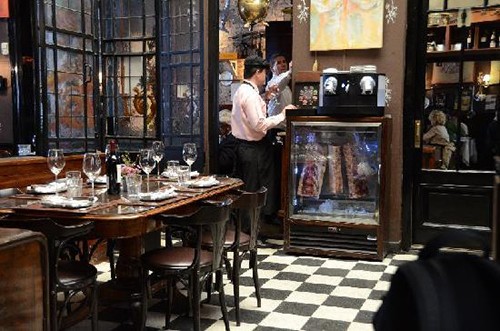No one can obviously live on steak alone. But for a couple of days, why not? On Buenos Aires in Argentina for a short visit, I readied myself for a high protein diet.
The people of Argentina have an infectious pride when it comes to their food, and the time spent chatting over meals sets the stage for some truly special eating experiences. You don’t get the typical South American spices in Argentina as food is served “au naturel.” In fact, critics have described Argentine cuisine as conservative, but this is the way the Argentines love their food.
IT’S ALL IN THE ARGENTINA MEAT
Beef dishes exhibit the undeniable quality of Argentina reared meat; and when combined with the surprising simplicity of its preparations, with seasoning rarely more than salt and pepper, it rightfully deserves its lofty reputation. You just need to remember a few key words: jugoso (very rare), a ounto (medium rare), or bien cocido (well done).
The cuts in Argentina are thicker than elsewhere in the world. And the focus is on places that source their meat from grass-fed cattle. In contrast to the common beef from the grain-fed cows, Argentina beef has better taste and is easier to digest.
Argentine beef is normally charcoal-grilled on a parilla. Most are flavorful on their own, but this doesn’t prevent restaurants from offering chimichurri sauce to complement the meat. Although if the meat is good, this sauce isn’t necessary. The servings in Argentina are huge, but it isn’t a faux pax to share with several people.
WHERE TO GO FOR BEEF IN ARGENTINA
For those looking to get their Atkins diets up and running, I would suggest a visit to an estancia outside Buenos Aires in Argentina, as well as to one of the many parillas operating in the city.
If you have time for just one steak dinner in Buenos Aires, head to La Cabrera in the Palermo Viejo district. Much has already been written about this parilla and it has become very popular after being highly recommended by many guidebooks, so the ensuing tourist rush to eat here has been phenomenal.
STILL THE SAME PLACE
Fortunately, it has managed to elude the downward spiral many such places with newfound fame usually encounter. In fact, a steady stream of portenos – as the locals are called – continue to favor this place, so the quality has been preserved and waitstaff continue.
Their tradition of service and attention. If you come early (before 10 PM), in all likelihood English will be the dominant spoken word. The atmosphere changes during the later hours when the locals arrive, and Spanish once again fills the air.
The other shocker is the bill. With a looming economic crisis and a severe shortage of dollars, most restaurants in Buenos Aires are open to negotiating the exchange rate for cash transactions, and it isn’t uncommon to receive a rate 70% above official bank guidelines. Dinner that evening for five hungry people set us back less than half the amount it would cost for a similar meal in Paris for one person.
In any case, there is always a long line outside, with some diners holding champagne glasses, and others working up an appetite while patiently waiting, with the wafting smells of grilled beef making the time seem interminable.
Don’t let all this waiting turn you off, though. The sidewalks outside La Cabrera are a great place to people-watch, with sharply dressed locals and more casually attired foreigners chatting. In fact, this place is so in vogue that the proprietor has had to open another one a few doors away, identical in experience to the original.
THE LA CABRERA EXPERIENCE
At La Cabrera, the crisp white table cloths are laid out but without the usual stuffy feeling. In fact, it is slightly cramped and a bit noisy. Each order comes with about a dozen side orders, ranging from mashed potatoes with Dijon mustard, tapenade, garlic cloves in red wine, pureed broccoli or squash, apple sauce, tartar sauce, lentils, corn, and avocado mash, just to name a few.
All these constitute a meal in itself, and yet you also have a choice of about two dozen different cuts of meat. When in doubt, however, the bifo de ojo or rib eye is always a good choice.
Starters are completely unnecessary, although we did try to “counterbalance” the steak with generous orders of arugula salad and tomatoes. A cursory look around told me that most tables opted for La Cabrera’s legendary starters of chorizo or goat’s cheese provolone. The service was slick, despite the broken English of the waitstaff and our halting Spanish.
TASTE THE DIFFERENCE
But the beef is clearly the star of the show. Argentine cows eat grass, the diet they were born to eat, making them healthier. The steaks are leaner than the grain-fed variety, but they are just as juicy as any and with a better flavor profile which was very noticeable and which I attributed to the cow’s natural diet. It had a beefier, “heartier,” and more intense taste.
DINNER AT LA CABRERA
It’s always odd to me when people complain about the taste of grass-feed beef. This is how beef should taste, as the cows eat what they should eat. Many places don’t have that kind of delicious steak, but the bifo de ojo at La Cabrera was perfect.
ARGENTINA’S HEARTLAND
The pampas are also worth visiting for a day trip. These are fertile evergreen grasslands that constitute Argentina’s most successful agricultural region.
There are some good estancias (haciendas) in and around the pampas; and many within a two-hour drive from Buenos Aires and definitely worth the effort. Watch the gauchos display their wares, sample authentic empanadas with wine, and then try the asado (barbecue).
At an asado, the gauchos will feed you sausages and ribs, and often everything else but the lungs and the heart of the cow. And at least you know where your animals are coming from, what they are eating and how they arrive on your plate.
EVERYTHING IS ON THE GRILL
An asado lunch at an estancia is not just a meal but a cultural initiation. Few things are as quintessentially Argentine as this sacred ritual of Argentine families that goes well beyond steaks to include other cuts of beef, sausages, offal, pork and chicken. Argentines clearly have none of the squeamishness of other nationalities over less desirable cuts of meat.
At an asado, the gauchos are in charge of the grill. This also includes the placing of charcoal underneath and the using of sea salt. They prefer to season before cooking and to keep the temperature low so cooking is slow.
They will feed you sausages and ribs, and often everything else but the lungs and the heart of the cow. And, at least at an asado in an estancia, you know where your animals are coming from, what they are eating and how they arrive on your plate.
While you’re there, you can even watch the cattle wander free in these naturally occurring grasslands and taste the difference. Happy cows make for healthier and tastier beef.
Then, after all that beef, wine and the gauchos, there is still tango, soccer and Evita to discover. What an amazing place.
Text by JEROME VELASCO.
Read more about Argentina in Travelife Magazine.










